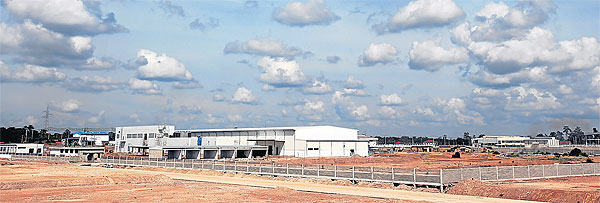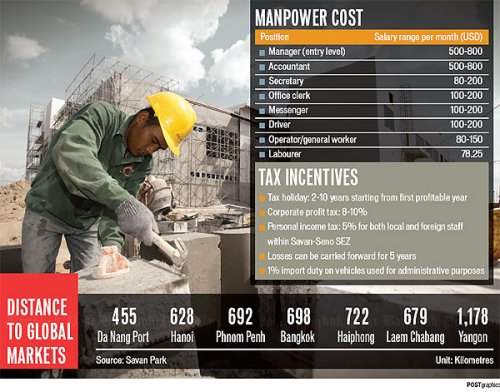Interest Picks Up In Savannakhet Industrial Zone
Before Thailand experienced its crippling floods in 2011 and the minimum wage hike in 2012, the Savan-Seno Special Economic Zone (SEZ), the first of its kind in Laos, was struggling to attract foreign companies. But now the location is gaining notice as a new choice for businesses looking for a low-cost, low-risk location.
Two of the pioneers at the site in Savannakhet have been Toyota Boshoku Asia, a major supplier of seats and interior parts for Toyota, and Nikon, the Japanese camera maker. Their presence is expected to draw other suppliers in the value chain as well.
However, much remains to be done in the second-largest province of landlocked Laos as it continues its slow transformation from an agriculture-based country to attract more industry. Developing skilled workers may be the priority at this stage; however, a well-planned policy to foster inclusive growth will be critical for the local government in the longer term.
Savan Park, or zone C of the SEZ, had 33 licensed investors as of May this year, including 11 Laotian companies. Most of them are the export-oriented businesses, said Tee Chee Seng, general manager of Savan Pacifica Development, the investor and operator of the industrial zone. The only company to have started operations so far is Aeroworks Co Ltd, a manufacturer of aircraft components, which also has a facility in Thailand.
Among the foreign companies building factories at Savan Park is Essilor, the French optical group that also has a manufacturing site in Thailand. Its Lao plant will make polycarbonate eyeglass lenses. Toyota Boshoku broke ground in mid-August and will start production in the second quarter of 2014.
Nikon, which is built its plant in zone B of the SEZ, is to start manufacturing parts for digital single-lens reflex cameras this month.
“There are many foreign companies, which have existing plants in Thailand, that want to set up new operations in other countries,” said Mr Tee. “Laos will be the location for their satellite manufacturing sites. Parts will be made here and sent back to Thailand for making finished products.”
Savan Pacifica Development is a 30:70 joint venture between the Laotian government and the Malaysia-based contractor Pacifica Streams Development, which is making its first foray into industrial estate operation.
Executives of the Malaysian company first visited Savannakhet in 2008 and liked the potential they saw. As the East-West Economic Corridor takes shape, products made at the site can be transported to Danang in Vietnam and via Thailand to Mawlamyine port in Myanmar.
Among the selling points of Savan Park are incentives that it says are better than those offered by Thailand’s Board of Investment (BoI). Companies can enjoy corporate tax holidays of two to 10 years from the first year they record profits. After that the profit tax will be just 8-10% depending on the industrial category. The personal income tax rate is just 5% for both local and foreign employees. All profits can repatriated to the companies’ home countries or third countries without any restriction. Export and import duties are also exempted.
In Thailand, the corporate income tax holiday is eight years. After that the tax rate is 23%. The personal income taxes ranges from 5% to 35%. Imported raw materials are free from tax from one to five years depending on the investment zone.
Even with the incentives, Mr Tee admitted that investors initially were wary about Savan Park because industrial development and infrastructure in Laos were limited. But the floods of 2011 and the increase in the minimum wage in Thailand in 2012 gave companies new reasons to look for alternative locations.
“Although the Thai government has promoted other locations safe from floods, the wage cost is another issue that industries have to think of. We got a lot of inquiries from companies that suffered from floods and labour costs in Thailand,” he said.
The minimum wage in Savannakhet is around 600,000 kip per month, which is equivalent to roughly 2,400 baht. The comparable figure in Thailand is 300 baht per day or 9,000 baht per month.
Despite the very attractive wage cost, Laos has a limited number of workers to supply to the industrial sector. The country has only 6.6 million people and skill levels are low.
“Automobiles are a sector that can locate here, but not electronics or labour-intensive industries. We do not encourage those industries to come Savannakhet at this time,” said Mr Tee.
In zone B of the SEZ, Nikon Lao is preparing to hold the grand opening of its camera-parts plant today. The parts will be shipped to Thailand for assembly into finished cameras at the Nikon factory in Rojana Industrial Park. Located in Ayutthaya, Rojana suffered severely from the floods in Thailand in 2011.
A company executive said Nikon was confident in the supply of workers in Savannakhet. Its factory needs 800 to 1,000 workers this year and is expected to employ 2,000 people by next year.
Nikon studied the labour supply in Savannakhet before making a decision. Champhon, the city where the plant is located, has a population of 11,000 including 62,000 people of working age. Among these workers, around 10,000 had migrated to work in Thailand, leaving a pool of about 52,000 people available.
“We wanted a supply of workers for our new manufacturing plants and Savannakhet can serve our needs,” said the executive. “The minimum wage is the issue for us. Floods in Thailand were another concern.”
More suppliers of Nikon are now expected to move to Laos to serve its manufacturing plants.
“A Japanese supplier has already bought land near our site. We did not force them to follow us, but I have to say that there is a sign that they will come here too,” the executive said.
The government of Laos, meanwhile, is responding to growing industrialisation by reforming its educational system, said an official with the Lao National Committee for Special Economic Zones.
More emphasis has been placed on vocational schools instead of universities so that the country can produce skilled workers to serve industry. It may take three to five years for the change to start producing results.
“Any developing nations should start from industrial activities,” said the official. “So, the focus is on the skilled workers, not the managers or those who will graduate from universities. At this stage, Laos has to produce more skilled workers.”
The government expects that the country has to start from labour-intensive industry before moving up to skill- and capital-intensive industries, which could take another decade.
“It will take time to change our populations’ mindset to see the importance of vocational studies,” said the official. “Most of them believe that graduating from universities will help them lift their standard of living.
“We have to show them that with vocational skills, they will have more job opportunities. Worker demand from Nikon and Toyota Boshoku can prove this.”
Because Savannakhet is home to the country’s first SEZ, changes in the educational system there are already well under way. It has 14 combined vocational schools and universities that can produce skilled workers. The SEZ is expected to need 5,000 workers by 2015 and 10,000 by 2018. The province, with a population of 900,000, currently produces around 10,000 graduates per year.
“The current population in Savannakhet is enough to supply industry. If the demand increases, we will recruit people who live in nearby provinces such as Champasak and Khammouane,” the official said.
The development of the SEZ has spurred the economy of Savannakhet, which has recorded average GDP growth of 12.5% over the past five years compared with around 8.3% for Laos as a whole.
Source: Bangkok Post


